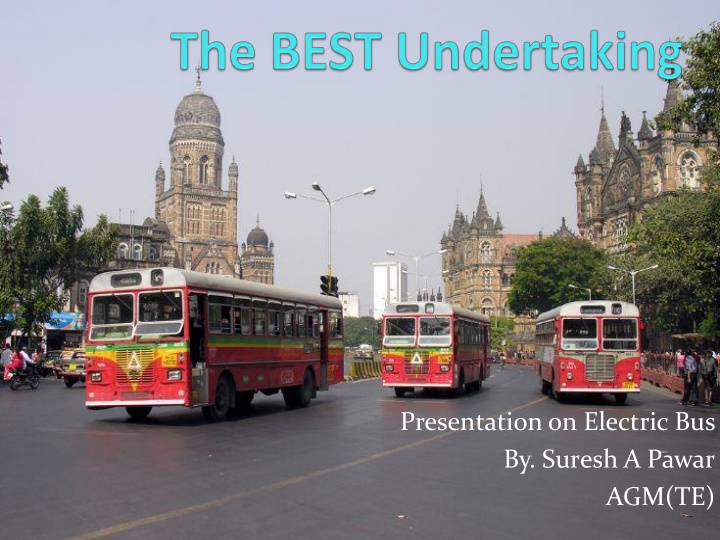



Presentation on Electric Bus By. Suresh A Pawar AGM(TE)
Fleet Composition of Buses Type of Fuel Type of Buses No’s of buses MIDI Buses 486 Single Decker 1904 CNG AC Buses 261 Total 2651 Single Decker Buses 1030 DIESEL Double Decker Buses 120 Total 1150 Total no. of Depots = 27 Central Workshop = 1 Total Fleet of BEST buses = 3801
Initiative Taken by BEST to Reduce Pollution The compressed natural gas has received a great deal of attention in reducing the emissions in 1990. 1 st CNG bus manufactured by Ashok Leyland was introduced in india in 1997 by BEST. After initial experience and substantial saving in the fuel cost and reduction in emission's BEST has increased CNG bus fleet up to 2651 buses which is 70% of the total fleet. BEST had carried out retro fitment of 720 diesel buses in to CNG buses in 2009-2010.
Initiative Taken by BEST to Reduce Pollution 25 no’s Hybrid electric buses will be inducted in to BEST’s fleet for BKC operation. These buses are being procured by MMRDA under FAME scheme. 303 EURO IV Diesel buses will be inducted into undertakings fleet in March 2017. Taking into the consideration of Zero emission, BEST has placed an order for procurement of 6 no’s Electric buses. These buses are expected by July 2017
Need of Electric Buses Fossil fuel stock is limited and it will not last long Consumption of Fossil fuel creates environmental issues Electricity required for charging of Electric Buses can be generated from renewal energy sources like Solar, Wind & Hydro Electric Buses are emission free buses and contributes towards green environment
Electric Bus type suitable for City Operation Type of buses suitable for city operation – Non AC MIDI buses with seating capacity in the range of 25 – 34. Non AC Single decker buses with seating capacity upto 45 Due to higher fare limited patronage of passenger is noticed on AC buses. Particularly AC bus services are used by office going people hence the travelling is unidirectional. Full utilization of AC electrical buses for passenger is not possible. If at all AC electrical buses are to be used it should be on the gross cost operating model, which will require more funding by DHI.
Operating Range and Charging Facility In Metropolitan cities the average vehicle utilization is in the range of 175 to 200 kms per day. The operating range of the electrical buses for Metropolitan cities should be 150 – 200 kms. In Metro cities all buses are stabled in the allocated depot in the night, hence charging facility should be at one depot only where these buses are allocated. The buses will be available in the depot for 4 – 6 hours in the night hence slow charging facility i.e. Full charging in 4 hrs. is recommended. The electrical buses should be with Onboard charging facility. Considering the time required for charging, for each two buses one charging point should be provided.
Challenges in operating Electric Buses Issues Methodologies to resolve the issue Operating Range In city operation average vehicle utilization is in the range of 175 to 200 KMS Charging Facility In city operation all buses are stabled in respective depots during the night hence charging facility only in depot is sufficient Charging In each depot electric sub stations are already installed for Infrastructure operating CNG stations. Same infrastructure can be used for charging of the Electric Buses. BEST is already in the business of Electricity Distribution. Charging Time Buses are available in night time for 4 to 6 hours hence initially slow chargers are preferred. Adoption of BEST has already adopted latest technology of BS III & BS IV Technology and also CNG technology. BEST has modern maintenance facility available at depot and central workshop.
Operating Models As the operating conditions differs from STU to STU and constraint for hiring of buses it is suggested to devise the scheme with following operating models. Capex Model 1. Opex Model 2. Gross Cost Model 3.
Necessity of Capex Model In Opex model electrical buses will be maintained exclusively by operator. Experience in technology and maintenance of electrical buses will be gained by operator and not by STU. In recent future use of electrical buses will be increased in many fold. Even metropolitan cities may be asked to run only electrical buses. To face such challenges STU should be equipped with technology of electrical buses. This objective can be achieved only through Capex model and not by Opex model.
Training To Adopt New Technology Technology of electrical buses is totally new to the STU, hence it is necessary to impart training on electrical bus technology to all technical officers and staff of STU. By gaining knowledge on electrical bus technology it would be easier for STU to maintain these buses satisfactorily. This would further help in adopting electrical buses on larger scale
Submission Vehicles pollute more when they run in low speed hence electric buses are needed more for intra city operation rather than inter city operation. For wider utilization of Electric buses non AC electric buses are preferred Funding under Capex, Opex as well as gross cost operating model shall be made available to STUs to select the best suitable operating model considering their operating constraints.
Recommend
More recommend